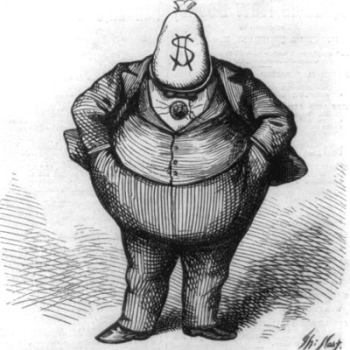Alice Tallmadge writes a first-person account of the “Satanic Panic” that first destroyed, then took, the life of her niece: “My Niece Believed She Was Abused By A Satanic Cult. The Truth Is Even Scarier.”
The personal details are unique, but the broad outlines of her story are not. Tallmadge accurately describes what happened to her family, and to many others throughout the country, during the peak of that particular manifestation of this ongoing Satanic Panic:
The panic also fueled a widespread belief that thousands of children were being kidnapped and tortured by members of underground satanic cults. That is how I was drawn into the panic. In 1989, my emotionally fragile niece, then 21, told her parents, two siblings and me that she had been abused by members of a satanic cult throughout her childhood.
I was dumbfounded at her disclosure. I was vaguely aware of the child care cases, but I knew nothing about the paranoia over ritual abuse that had been creeping across the country, or the growing belief in the veracity of what were called “recovered memories” of childhood abuse. I considered satanic cults a byproduct of medieval superstition; my niece considered them frighteningly real.
They took her at night, she told me, subjected her to torture and abuse, gave her something to make her forget, then brought her back home. One specific, excruciating torture she talked about, which she called “The Marionette,” was being strung up in a way that had her joints bend the opposite from how they were supposed to function.
As difficult as it was to hear my niece’s “memories,” the speed at which some of her family members accepted them as true was also disturbing. In a matter of months, my relatives came to believe an underground satanic cult was operating undetected throughout the country, kidnapping children, abusing them and programming their minds to obey the will of the cult. Sex abuse was the least of it ― young women were reportedly used as breeders to deliver infants that were cut up and used in sacrificial rituals. Sometimes the young women were allegedly made to wield the knives themselves and ingest the tiny body parts. My niece, who couldn’t tolerate the thought of any creature enduring pain, came to believe that’s what she had done.
So devious, so sophisticated was the cult ― I was told ― that it never left behind any tracks. That’s why police couldn’t find evidence. And children never told, they said, because they were warned they would face unthinkable consequences if they did.
What made seeking the truth even more difficult was that those caught in the sway of the panic disavowed anyone who didn’t embrace their beliefs. Their prevailing creed was: If you don’t believe us, you must be in league with them.
The story did not end well for Tallmadge’s niece. The story did not end well for anyone.
The story did not end.
The Satanic Panic got pushed down beneath the surface in the 1990s, but it never went away. It can’t, because it’s a more vivid expression of a fundamental “belief” at the heart of American politics and American culture: the claim that millions of our neighbors are murderous servants of Lucifer, slaughtering innocent babies by the millions.
Tallmadge’s story comes from 1989. This video is from this week:
Jerome Corsi here is spinning the same tale that Mike Warnke and Michelle Remembers spun in the 1980s. We can’t ignore him as a negligible fringe figure — this is the man whose “Swift Boat” conspiracy theories likely tipped the 2004 election.
Corsi’s claims of a conspiracy of Satanic baby-killers, like Warnke’s claims back in the day, are pure bullshit. That claim in all of its forms always is. The Satanic Panic in all of its forms is pervasively disingenuous, an exercise in bad faith. But that’s not just true of the transparent hucksters profiting from selling such conspiracies. It’s also true for their alleged dupes and the vast army of “true believers” eagerly buying what they’re selling.
Tallmadge writes with dismay that “my relatives came to believe an underground satanic cult was operating undetected throughout the country, kidnapping children, abusing them and programming their minds to obey the will of the cult.”
This is what those relatives said they believed. But they could not have fully believed this. Their own “defense” of the claim demonstrates that. That defense is based, start-to-finish, not on its glibly inadequate “explanations” for the utter lack of any evidence, but on its insistence that the seeking of evidence is unnecessary. That the desire for evidence is forbidden. The seeking of evidence and the desire for evidence is recast as a betrayal — one that makes any such skeptical evidence-seeker a de facto collaborator with the conspiracy.
The argument for the sincerity of their belief is based on the magical effectiveness of this dismissive reinforcement mechanism. That mechanism treats the total lack of evidence as all the evidence that’s needed. And it renders any challenge moot because, as Tallmadge writes, “If you don’t believe us, you must be in league with them.”
But the foundational insincerity of this belief is demonstrated by this same magic trick. Because it’s a magic trick — a self-proclaimed illusion, an enchantment, a claim of cause without effect. The seeking of evidence is forbidden because it would spoil the trick. It would ruin the excitement.
Look at how the family responded to this poor niece’s claim of being subjected to “The Marionette.” They didn’t take her to the hospital for an MRI in order to either confirm or falsify that her joints had all been hyperextended. Instead they took her to a hypnotist, someone who might seem to confirm the claims but who could not threaten the exciting drama of the game by threatening to disprove that this torture had taken place. They sought reinforcement and avoided potential refutation because they didn’t want to spoil the trick or ruin the excitement.
I appreciate that this suggestion is extremely unpleasant. “Again, I’m not happy to be saying such things about anyone, and I’m only doing so here reluctantly …” The “true believers” in these conspiracy theories are only able to sustain this “true belief” by actively rejecting the perpetual assault of evidence disproving it while also actively ignoring the utter lack of any evidence confirming it. That takes work — work that one must choose, and choose constantly, until eventually the cumulative weight of that repeated choosing makes it enough of a habit that such choosing becomes gradually less conscious. But never fully unconscious.
At bottom, such conspiracy theories cannot be believed due to bad information. They can only be believed due to bad choices. And thus to bad faith.












